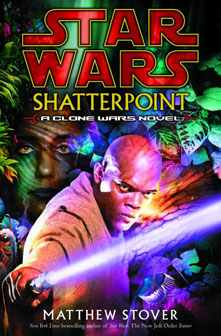“Shatterpoint” (2003) has a number of firsts to its credit: It was the first published “Clone Wars” novel and the first story to explore Mace Windu in-depth. Now, with the publication of “A New Dawn,” it has the ignominious distinction of being the first great work of the Expanded Universe to be erased by the new Disney canon.
In “A New Dawn,” Depa Billaba is the Master of young Kanan Jarus (Freddie Prinze Jr.’s character on “Rebels”). She dies in Order 66 and he emerges 15 years later on “Rebels.” While some fans might try to retcon the two continuities, it seems impossible that the Depa we know in “Shatterpoint” would regain her good standing with the Jedi Order. The last time we see the Legends version of Depa is in “Republic” Issue 66, when she’s in a coma on Coruscant, under the watch of Mace Windu. Were she to wake up, she would be tried for crimes against civilization. (The Disney version of Depa will be explored further in next year’s comic, “Kanan.”)
The story of Depa’s war crimes is told in Matthew Stover’s masterful “Shatterpoint.” Over four novels, Stover earned his reputation as the go-to guy for beefing up characters. He did it for Jacen Solo in “The New Jedi Order: Traitor,” then for Mace in this novel, then for Anakin Skywalker in the “Revenge of the Sith” novelization, then for Luke Skywalker (particularly the military commander aspect of his personality) in “Luke Skywalker and the Shadows of Mindor.”
Before this book, we knew Mace Windu largely because we knew Samuel L. Jackson – he was the cool, no-nonsense, supremely confident warrior, perhaps prone to the occasional deadpan one-liner. The “Clone Wars” animated shorts showed us his ability to find “shatterpoints” to blow up Separatist war machines using the Force, and Stover expands on that, noting that Mace can sense shatterpoints in the galactic conflict. Early in the novel, he thinks Dooku was a shatterpoint, and he blew it by not killing him at Geonosis. At the end, he believes Anakin is actually the war’s shatterpoint – of course, he misreads this as being a good thing, thus leaving him prone to Anakin’s betrayal in “Episode III.”
“Shatterpoint” is the thickest “Clone Wars” novel, but it has little to do with the wider Republic vs. Separatist conflict. Essentially, those two sides each back a side in the endless Summertime War on Mace and Depa’s home planet of Haruun Kal (think of the Israel-Palestine conflict, except set in the jungle). It’s also a Light Side vs. Dark Side novel, but – as Stover did with “Traitor,” where he controversially portrayed the Force as a continuum, rather than something that has two distinct halves – it dodges the traditional Force clichés, which tend to obsess over a Jedi’s control of his or her internal feelings. “Shatterpoint” is about actions during wartime and how those fit into the moral tenets of the Jedi Order (in short: they don’t).

The jungle of Haruun Kal – in addition to having naturally dangerous flora and fauna (we again meet the ankylosaurus-like akk dogs, first introduced in “Republic” arc “Emissaries to Malastare,” which also introduced Mace and Depa’s father-daughter-like relationship) – is a war zone, so Depa makes wartime decisions. She sides with the jungle-based Korunnai (her and Mace’s ancestors, who are native to the planet and all of whom can tap into the Force). But when Mace comes in, he tries to save as many lives as he can on both sides, Korunnai and Balawai (the city-based offworlders who are backed by the Separatists) alike. So Mace makes enemies of everyone he encounters. He eventually gains an ally in young Korunnai Nick Rostu, but he rejects the overtures of alliance from Korunnai warmonger Kar Vastor, even though they share the same ghosh (clan). Mace says his clan is the Jedi.
Mace finds it difficult to limit bloodshed on both sides, as he reflects on the second-to-last page:
“It’s war. Not just that war, but war itself. When every choice you make means death. When saving THESE innocents means THOSE innocents must die. I’m not sure that any Jedi can survive such choices for long.”
In “Shatterpoint,” Mace gains a full understanding of war in the only way a person can – by being in the thick of it. A visceral example comes when Separatists bomb the caves where sick and injured Korun refugees are holed up. The way Stover describes the sound and fury calls to mind accounts of Middle Easterners who are being drone-bombed by the U.S.: They have learned to fear the sky. Not that Mace was ever pampered, but about midway through this epic jungle trek, he desires nothing more than a shower back at the Jedi Temple – so in that sense, he’s the surrogate of the reader lounging on his couch and being able to escape the Summertime War by setting down the book.
Stover also peppers in insights specific to Mace: Notably, we learn that he’s uncomfortable looking at clones with their helmets off, because he sees the face of Jango Fett.
The only downside of “Shatterpoint” is that Stover’s wrap-up of the Summertime War is ridiculous. Mace (suddenly possessing a Christ-like sway over folks) teams up with the Balawai general, and together they get all the warriors on both sides – except those who will transition from soldiers to “peacekeeping” police officers — to turn in their weapons, thus ushering in an era of peace. Um, no. First of all, people who have known only war will not voluntarily give up their means of self-defense; it will have to be taken from them by force. Secondly, centuries-long conflicts like the Summertime War (and what’s going on in the Middle East and Africa) can’t be ended overnight by the word of a couple of charismatic leaders. It’s a beautiful idea, but not backed up by anything throughout human history.
“Shatterpoint” should have ended with the war continuing, but Mace escaping back to the more “civilized” Clone Wars along with his new ally Nick and his two prisoners, Depa and Vastor. The final statement should have been that all you can do is hope to escape the Haruun Kal jungle; you can’t change it, because – as Stover writes multiple times – the jungle (and, by extension, the ongoing violence) is what it is. In the long term, a free-market economy (in the book, the Separatists assert an iron grip on the planet, which produces a valuable tree bark) might show the people of Haruun Kal the wealth that can come from peaceful cooperation, but I don’t believe there would be an immediate Pollyanna solution like Stover suggests.
Still, I’ve never been the type of reader to say a story is ruined by the ending. Ninety-five percent of “Shatterpoint” is great, and it ranks as a must-read for “Star Wars” fans. Just prepared to invest time and thought into this novel. It’s worth it, because while most other stories are content to leave Mace Windu as an amalgam of traits from Sam Jackson’s action-movie characters, “Shatterpoint” gives a complete picture of a Jedi who is a deadly warrior when he needs to be – but who tries desperately (and often fails, to his dismay) to find solutions other than killing.

